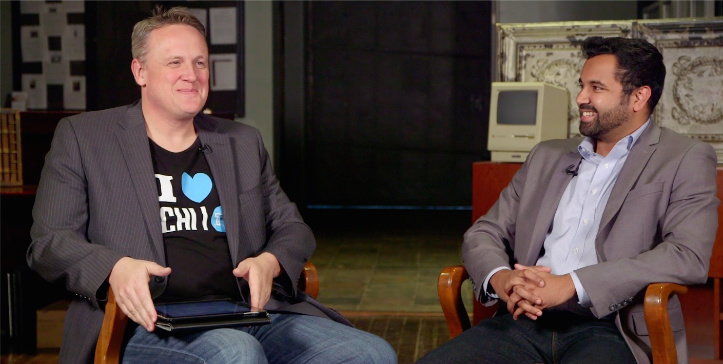What’s the most important thing to remember when pitching your tech release or launch to a journalist? The following answers are provided by members of Young Entrepreneur Council (YEC), an invite-only organization comprised of the world’s most promising young entrepreneurs. In partnership with Citi, YEC recently launched StartupCollective, a free virtual mentorship program that helps millions of entrepreneurs start and grow businesses. 1. Bring Big Potential  Journalists like to know that you’re not just somebody that’s entering a market that doesn’t exist. They want to know that this is a large opportunity and a lot of people would be interested in your company. This is what drives page views and pays their bills. I like to point out large competitors that have raised a lot of money. It’s a way to show them that the market is out there. – John Rampton, Host 2. Focus on Unique Data or Current Market Trend
Journalists like to know that you’re not just somebody that’s entering a market that doesn’t exist. They want to know that this is a large opportunity and a lot of people would be interested in your company. This is what drives page views and pays their bills. I like to point out large competitors that have raised a lot of money. It’s a way to show them that the market is out there. – John Rampton, Host 2. Focus on Unique Data or Current Market Trend  Just because you think your release or launch is newsworthy does not mean journalists agree. Be mindful of the topics/areas specific journalists cover and pitch them based on their areas of expertise and interest. Most importantly, dovetailing your launch with a current market or small business trend or providing exclusive data can also increase the likelihood of your story getting picked up. – Sharam Fouladgar-Mercer, AirPR 3. Make Sure They Truly Care
Just because you think your release or launch is newsworthy does not mean journalists agree. Be mindful of the topics/areas specific journalists cover and pitch them based on their areas of expertise and interest. Most importantly, dovetailing your launch with a current market or small business trend or providing exclusive data can also increase the likelihood of your story getting picked up. – Sharam Fouladgar-Mercer, AirPR 3. Make Sure They Truly Care  It seems easy to remember, but make sure the journalist you’re pitching has a special affinity in writing articles similar to your product/service/issue. They’ll be more receptive to your pitch if you can find a way to resonate with them on something they enjoy writing about or believe in. – Kenny Nguyen, Big Fish Presentations 4. Understand the Audience
It seems easy to remember, but make sure the journalist you’re pitching has a special affinity in writing articles similar to your product/service/issue. They’ll be more receptive to your pitch if you can find a way to resonate with them on something they enjoy writing about or believe in. – Kenny Nguyen, Big Fish Presentations 4. Understand the Audience  Depending on the news outlet the journalist represents, you should cater to their target audience when pitching your tech release or product launch. In some cases you may need to be more general in how it helps a certain demographic, in other cases you may want to be more detailed and technical. – Phil Chen, Systems Watch 5. Don’t Sell, Sell and Sell
Depending on the news outlet the journalist represents, you should cater to their target audience when pitching your tech release or product launch. In some cases you may need to be more general in how it helps a certain demographic, in other cases you may want to be more detailed and technical. – Phil Chen, Systems Watch 5. Don’t Sell, Sell and Sell  Make your pitch short and sweet. Have ready several different ways to phrase your answers. But, most of all, listen to the journalist’s question and then answer it. Don’t keep selling. Directly answer the question he or she is asking, using their words as your guide in the answer. – Peter Daisyme, Hostt 6. Start a Relationship
Make your pitch short and sweet. Have ready several different ways to phrase your answers. But, most of all, listen to the journalist’s question and then answer it. Don’t keep selling. Directly answer the question he or she is asking, using their words as your guide in the answer. – Peter Daisyme, Hostt 6. Start a Relationship  Would you launch into a seven paragraph monologue with a hyper tone with someone you just met? No. So don’t send a journalist an email with six paragraphs about your revolutionary “next Facebook” app or whatever to a writer who doesn’t know you from the 218 other people who just emailed that day as well. Be brief, be friendly, and look to START a relationship. This is how to pitch. – Beck Bamberger, BAM Communications 7. Get Your Story Straight
Would you launch into a seven paragraph monologue with a hyper tone with someone you just met? No. So don’t send a journalist an email with six paragraphs about your revolutionary “next Facebook” app or whatever to a writer who doesn’t know you from the 218 other people who just emailed that day as well. Be brief, be friendly, and look to START a relationship. This is how to pitch. – Beck Bamberger, BAM Communications 7. Get Your Story Straight  It’s important that you have a defined backstory. Knowing just how you want to portray your journey will make it easier for you to talk, and for the journalist to adapt what you’re saying into compelling writing. – Simon Casuto, eLearning Mind 8. Focus on What They Are Looking For
It’s important that you have a defined backstory. Knowing just how you want to portray your journey will make it easier for you to talk, and for the journalist to adapt what you’re saying into compelling writing. – Simon Casuto, eLearning Mind 8. Focus on What They Are Looking For  The things executives are proud of and the things most people find interesting don’t always overlap. Put yourself in the shoes of readers and think about what’s going to excite them, not your board members. – Sam Saxton, Salter Spiral Stair and Mylen Stairs 9. Focus On the ‘How’
The things executives are proud of and the things most people find interesting don’t always overlap. Put yourself in the shoes of readers and think about what’s going to excite them, not your board members. – Sam Saxton, Salter Spiral Stair and Mylen Stairs 9. Focus On the ‘How’  You always want to focus on what you’re allowing people to do, not necessarily how they are able to do it. Keep the technical jargon to a minimum and show people how you’re solving a problem. – Tolga Tanriseven, GirlsAskGuys
You always want to focus on what you’re allowing people to do, not necessarily how they are able to do it. Keep the technical jargon to a minimum and show people how you’re solving a problem. – Tolga Tanriseven, GirlsAskGuys
10. Make It Easy
 In the new world of media relations, you are essentially selling content. If the content is weak, a digital editor risks losing viewers. Remember, digital editors are only going to push forward interesting content that will increase viewership. Make it easy for the journalist to run your story and you will increase the likelihood of being featured. – Kris Ruby, Ruby Media Group
In the new world of media relations, you are essentially selling content. If the content is weak, a digital editor risks losing viewers. Remember, digital editors are only going to push forward interesting content that will increase viewership. Make it easy for the journalist to run your story and you will increase the likelihood of being featured. – Kris Ruby, Ruby Media Group
11. Be Clear and Brief  It’s impossible to describe everything about a technology in a few sentences or seconds, but it is possible to briefly articulate in common language the problem it solves, why it matters and how it’s unique. Imagine a life where everyone is constantly bombarding you with pitches; that’s the life of a journalist. Our job is to make that life a little easier with brevity, clarity and relevance. – Steven Berlin, Uskape
It’s impossible to describe everything about a technology in a few sentences or seconds, but it is possible to briefly articulate in common language the problem it solves, why it matters and how it’s unique. Imagine a life where everyone is constantly bombarding you with pitches; that’s the life of a journalist. Our job is to make that life a little easier with brevity, clarity and relevance. – Steven Berlin, Uskape









